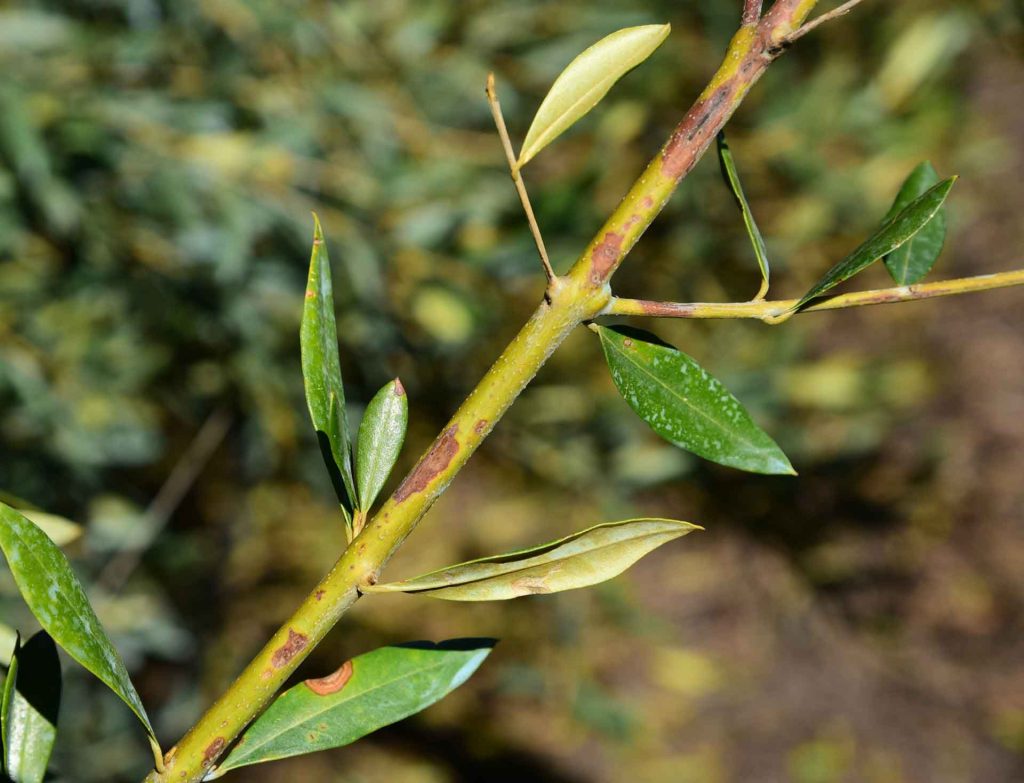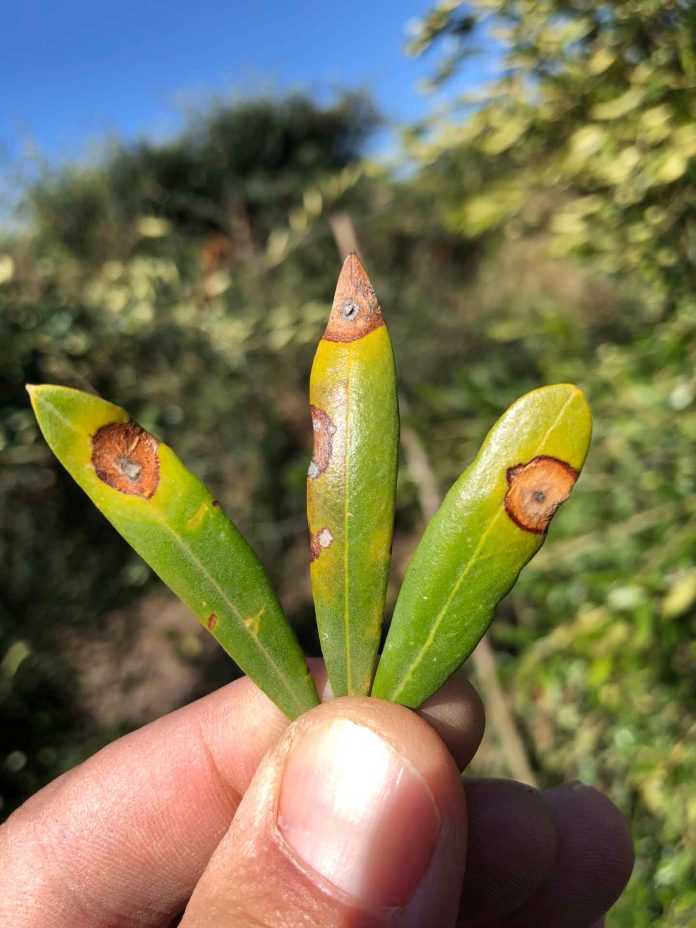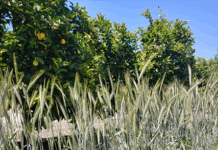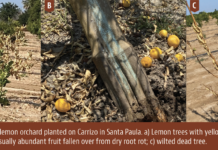Neofabraea leaf and twig lesions were first detected in California super-high-density oil olive orchards in 2016. Since then the disease was found in Glenn, San Joaquin, and Stanislaus Counties. Causal agents of this new disease of olive were identified as Neofabraea kienholzii and Phlyctema vagabunda (syn: Neofabraea vagabunda). Phlyctema vagabunda is known in Spain as the causal agent responsible for the olive leprosy or lepra fruit rot, causing fruit malformation as well as leaf lesion and twig canker. This disease is of increasing concern in Spain, Portugal and Italy. Dr. Trouillas at UC Davis has outlined the disease epidemiology, disease cycle, and determined best spray timings and materials that will help to control this disease.
Disease Symptoms
Neofabraea leaf and twig lesions are primarily associated with wounds, such as those sustained during mechanical harvest. Leaf lesions are circular to elongate, necrotic, approximately 0.5 to 1cm in diameter and normally do not number more than one lesion per leaf (Figure 1). Twig lesions are reddish-brown in color mainly affecting the bark tissues (Figure 2). The disease may occasionally cause fruit rot near the time of harvest. In severely infected orchards, defoliation and fruit loss may occurr.
Disease Biology
Two fungal pathogens have been identified using morphological and molecular techniques: Neofabraea kienholzii and Phlyctema vagabunda (syn: Neofabraea vagabunda). These pathogens have been associated with bull’s eye rot and canker of apples and pears in the Pacific Northwest.
In olive, the disease has been detected primarily from super-high-density oil olive orchards in Glenn, San Joaquin and Stanislaus counties. The cultivar ‘Arbosana’ is the most susceptible but the disease has also been isolated on occasion from ‘Arbequina’ olives in the Central Valley. It was not found in the Koroneiki cultivar. Previous reports of the disease in California olive have included fruit spots in ‘Cortina’, ‘Picholine’ and ‘Frantoio’ varieties in Sonoma county. To date, table olive varieties (Manzanillo and Sevillano) in the Central Valley have not tested positive for Neofabraea leaf and twig lesions.
Infection occurs at the site of plant injuries. In super-high-density oil olives, these wounds are typically associated with damage caused by mechanical harvesters but may also include abrasion sites where leaves or twigs rub against each other. Following mechanical harvest, rain events allow for fungal inoculum to be released in the air, leading to infection of the fresh wound sites. Leaf spot symptoms are most visible in March, with defoliation occurring in April and May. Infected leaves and fruits act as inoculum sources for infection the following year.
Disease Management
Field trials have been conducted for three consecutive years in the highly susceptible Arbosana cultivar to determine fungicide efficacy. Results showed that several products were effective in reducing infection by the pathogens and limiting disease incidence. Overall, best disease control was achieved by Topsin M, Vanguard, Inspire Super, Bravo and Ziram fungicides, which provided up to 75 percent reduction in disease incidence. Copper fungicides did not control the disease. Comparison of different fungicide application regimes showed that one to two applications after harvest significantly reduce disease incidence. Two independent wound susceptibility trials were conducted also to determine the duration (0, 1, 2, 3, 4 or 5 weeks) when wounds on leaves remain susceptible to infection, and thus determine the number and timing of fungicide applications required to control Neofabraea and Phlyctema diseases. Results showed that leaves inoculated immediately after wounding (harvest) and those inoculated one week after wounding were the most susceptible to infection. Overall, leaf wound susceptibility to infection declined substantially after four weeks following wounding. This suggests that wounds had healed after four weeks following a wounding event at harvest and that one fungicide application after harvest followed by a second application two to three weeks later should suffice to protect olive trees from infection.

Next Steps
Two fungicides were nominated to the IR-4 program in 2018: Ziram (Ziram 76WDG) and difenoconazole/cyprodinil (Inspire Super). These fungicides were approved for residue trials at the National Food Use Workshop in September for registration on olives. Strong support was provided based on the after-harvest and winter season usage with expected zero to limit-of-detection residues on the crop in the following harvest season. Ziram is a FRAC Code M3 whereas Inspire Super is a FRAC Code 3/9. Thus, integration of multi-site modes of action for both products was also established as an effective anti-resistance strategy. Ziram and Inspire Super were also submitted for section 18 emergency exemptions, which are expected to come into effect during the course of 2020. The availability of these two fungicides in olive will improve control of Neofabraea and Phlyctema leaf and shoot lesions and will allow for management of fungicide resistance by rotating modes of action.
Acknowledgements
We are thankful to the Olive Oil Commission of California for funding this research.




















